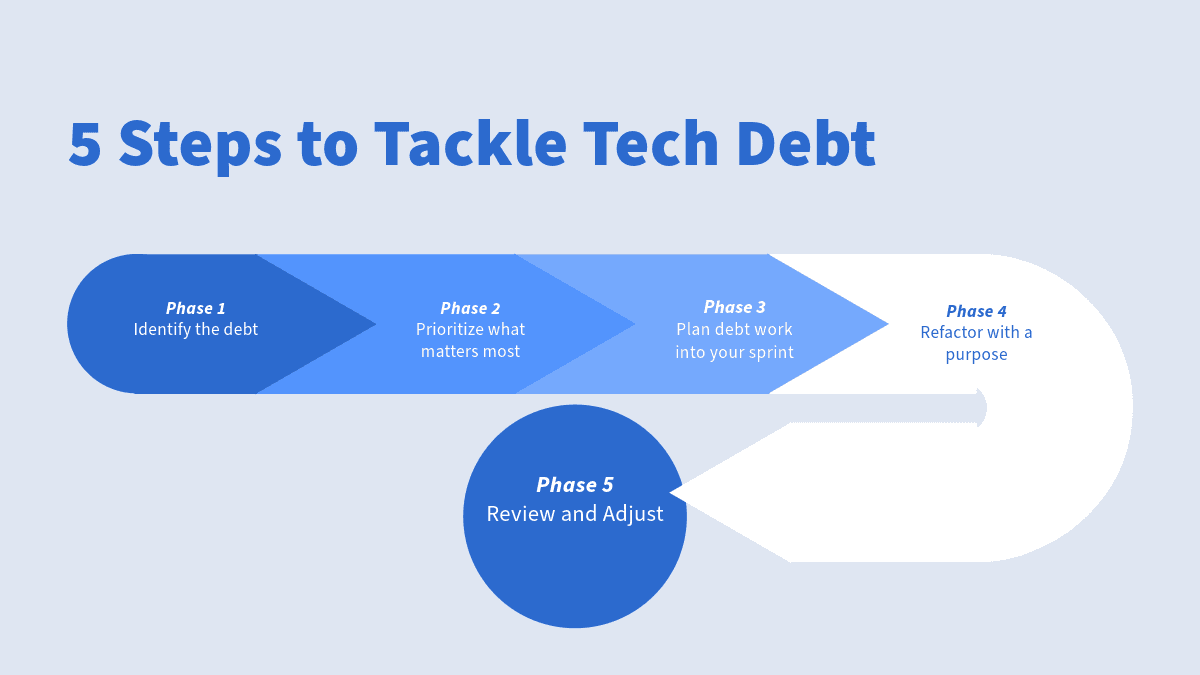Technical Debt: What It Is, Why It Happens, and How to Manage It

About us
MoldoWEB is a software development company, located in Romania, specialized in providing outsourcing and team augmentation services for clients around the world.
Table of contents
- What Is Technical Debt and Why Does It Happen?
- How to Spot Technical Debt
- Managing Technical Debt
- The Risks of Ignoring Technical Debt
- Wrapping It Up
Working on your software has some not-so-glamourous parts to it, such as running into technical debt. In software development, this is something that builds up over time if you keep ignoring it.
The term “technical debt” might sound like something went wrong, but that’s not necessarily the case every time. It could just be the result of moving too fast and cutting corners to meet a deadline. This can happen pretty often with software projects.
Let’s take a look at what technical debt actually is, why it happens, how to spot it early, and some simple ways to deal with it.
What Is Technical Debt and Why Does It Happen?
To simply explain the meaning of technical debt, imagine this: you’re building a new feature for your app, and there is a cleaner way to do it, but that would take too long. And with the deadline being close, you decide to do it another way and just clean it up later. That’s it. That’s technical debt.
If you want a more detailed breakdown, this guide from Atlassian explains it well in an easy-to-follow way.
Let's take a development team that started working on this internal admin dashboard as an example. They needed to add role-based access controls, but setting up a proper system would have taken too long. So, instead, they added a few “if” statements based on user roles, which was a bit messy, but it worked. Fast forward a few months, they had more and more roles, edge cases, and conditions that nobody wanted to deal with. This is the debt part: saving time and effort earlier, but paying for it later in maintenance and headaches.
The thing is, technical debt doesn’t always happen because of cutting corners. Sometimes, it’s just time passing and changing needs. What worked in version 1.0, doesn’t fit the app anymore. Libraries get outdated, APIs change, etc.
So, yeah, technical debt isn’t just the result of bad code. To sum it up, it’s the cost of building things quickly or building them before having everything figured out.

How to Spot Technical Debt
Spotting technical debt is actually not that hard, as there will be some pretty obvious signs and annoyances that stack up over time.
For example, if you have a messy file with way too many responsibilities or weird processes that nobody’s wanted to handle since 2021, those are red flags. And debt.
Here are some common signs we’ve seen:
You’re afraid to make changes: If you don’t want to deal with some parts of your code because you’re scared it might break everything, that’s a problem. Clean code should give you confidence, not anxiety.
Fixing one bug creates two more: If you find yourself in the never-ending circle of fixing bugs or tweaking something that makes the UI break, this usually means that your code isn’t modular or clear, and you have too many things tangled together.
Onboarding new devs is painful: If it takes weeks to figure out the logic behind different features, that signals that things aren’t well organized within your codebase.
You’re copy-pasting a lot: When you keep reusing the same code parts with minimal changes, it probably means that something should be abstracted but hasn’t been.
You keep saying "we’ll clean this up later": This is a clear warning sign. When you keep postponing stuff for later over and over again, the debt pile will keep getting bigger. And eventually, you will have to deal with it.
Managing Technical Debt
Something to keep in mind is that you’ll probably never have zero technical debt. And that’s okay. Keeping it in control is better than trying to eliminate it entirely.
If you have code debt piled up, don’t let it sit in the shadows for too long. Keeping a list can help. Adding a tech debt ticket to your backlog is also a good strategy you can include in your processes.
Some debt is just annoying, but harmless. But some debt is also blocking your progress. Make sure to focus on the one that’s slowing you down. Think of it this way: if there is one thing that will save you hours every sprint, it’s worth looking into and fixing it.
Not every fix needs to be a big rewrite. Sometimes, just taking 30 minutes to clean up a function before you work on it can save you from future headaches.
Automate the processes you can. Use linting, tests, and formatting. These can be of huge help and catch a lot of mess before it piles up. This way, you can also focus on more challenging tasks.
Many businesses partner with software outsourcing companies to handle parts of their IT projects, like maintenance and managing technical debt, so they can stay focused on their core tasks, knowing their software is in good hands.
In technical debt, it’s also important to know that in some cases, it can be cheaper to “let go” than take weeks to fix something to perfection. If the code works and doesn’t affect anything, maybe it’s okay as is.

The Risks of Ignoring Technical Debt
Technical debt usually starts small, and most of the time, it’s an easy fix…until it’s not. The problems start when you push it to the side for too long. You will know you have a technical debt problem when you start spending more time going back and fixing stuff rather than building something new.
Performance issues can creep in, too. That one query you never got around to optimizing? Multiply that by 100 users, and now your app has slowed down. And let’s now even get started on bugs, especially the ones that only show up in production.
Worst part? Many new developers dread onboarding because the codebase feels like a haunted house. And that slows down your whole team.
Basically: the longer you wait, the messier (and costlier) it gets to clean up. It’s like ignoring a leaky roof. Sure, you can stick a bucket under it for a while. But eventually, you’ll need to fix the ceiling…and maybe the floor, too.
Wrapping It Up
When it comes to technical debt, look at it as something that will most likely become part of your software project. It’s up to you how and when you deal with it. The sooner is always the better, though. Otherwise, the longer you wait, the more effort and time you’ll need to put into fixing stuff, which can affect your productivity and slow everything down.
If you keep an eye on it and handle the messy parts without letting them pile up too much, it becomes manageable.
So, yeah, it’s okay to ship fast when you need to, but don’t forget to go back and clean up regularly.


